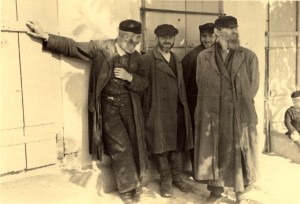A large number of Jews lived in Sokolow. City inventories clearly noted a significant number of them here. Old-monks appeared in the city in the 16th century, together with flow of wide range of people in particular to private cities in Podlasie, which, as opposed to royal centres, did not have privilege of de non tolerandis Judaeis.
 Since the beginning in the 16th century, Jews from Lithuanian appeared in Podlasie (which were expelled from the Grand Duchy of Lithuania in 1495 by Alekxander, due to his rule) and refugees from the cities of the Crown, which were granted privilege of de non tolerandis Judeais, then population from Germany after cruel prosecutions, and refuges following the army of Chmielnicki. Jews had their own municipal government (Kahal) and large autonomy. Communities, in addition to religious and social functions (synagogues, baths, schools) met significant administrative role (division of taxation, judiciary, etc.). They were organized in larger units of Kahal organizations – for larger areas and with larger number of communities – in governs (medina) , in smaller in districts (galil). In the early formation of the Jewish communities in these areas, i.e. in the 16th century, the Jews of Podlasie, along with the largest community in Tykocin, were part of the Lithuanian regional councils and others after including of Podlasie voivodeship to the Crown in 1569. In 1580, after establishment of Sejm of Polish Jews, Jews of Podlasie were still in Lithuanian administration. This was also when Lithuanian Jews separated from the Crown and in 1623 organized their own Sejm. It was only in 1629, when Jews came to Sejm of Jews of the Crown, in which they were as Podlaski district until the 2nd half of the 17th century. Then dwo districts were established in Podlasie voivodeship: Wegrowski and Tykocinski. Five municipalities in Drohicka land were subject to Wegrowski district: Wegrow, Kosow, Mokobody, Mordy and Sokolow. They were basically by kahals, using limited powers (did not participate in taxes division, had less judicial powers) in relation to the parent community in Wegrow (Jews had been here at least since 1537, and Kahal existed in 1595). Jews can be classified as urban population, who carried out non-agricultural activities. On the basis of the privilege by Boguslaw Radziwill of 18th November 1650, Jews from Sokolow Jews could make any purchases, trade and drink alcohol, deal with crafts. In 1665, in Sokolow Jewish community was founded as the first in Podlasie, gathering brewers. In 1775, there was Sokolow kahal included the city of Sokołow (587 of old-monks), the city of Sterdynia (88), parish villages of kahal (729).
Since the beginning in the 16th century, Jews from Lithuanian appeared in Podlasie (which were expelled from the Grand Duchy of Lithuania in 1495 by Alekxander, due to his rule) and refugees from the cities of the Crown, which were granted privilege of de non tolerandis Judeais, then population from Germany after cruel prosecutions, and refuges following the army of Chmielnicki. Jews had their own municipal government (Kahal) and large autonomy. Communities, in addition to religious and social functions (synagogues, baths, schools) met significant administrative role (division of taxation, judiciary, etc.). They were organized in larger units of Kahal organizations – for larger areas and with larger number of communities – in governs (medina) , in smaller in districts (galil). In the early formation of the Jewish communities in these areas, i.e. in the 16th century, the Jews of Podlasie, along with the largest community in Tykocin, were part of the Lithuanian regional councils and others after including of Podlasie voivodeship to the Crown in 1569. In 1580, after establishment of Sejm of Polish Jews, Jews of Podlasie were still in Lithuanian administration. This was also when Lithuanian Jews separated from the Crown and in 1623 organized their own Sejm. It was only in 1629, when Jews came to Sejm of Jews of the Crown, in which they were as Podlaski district until the 2nd half of the 17th century. Then dwo districts were established in Podlasie voivodeship: Wegrowski and Tykocinski. Five municipalities in Drohicka land were subject to Wegrowski district: Wegrow, Kosow, Mokobody, Mordy and Sokolow. They were basically by kahals, using limited powers (did not participate in taxes division, had less judicial powers) in relation to the parent community in Wegrow (Jews had been here at least since 1537, and Kahal existed in 1595). Jews can be classified as urban population, who carried out non-agricultural activities. On the basis of the privilege by Boguslaw Radziwill of 18th November 1650, Jews from Sokolow Jews could make any purchases, trade and drink alcohol, deal with crafts. In 1665, in Sokolow Jewish community was founded as the first in Podlasie, gathering brewers. In 1775, there was Sokolow kahal included the city of Sokołow (587 of old-monks), the city of Sterdynia (88), parish villages of kahal (729).
In 1827, there were approximately 37% Jews in whole Sokolow population, and in 1875 there were more than 60%. As a result of World War I the number of old-monks decreased to 55% of the total population. Just before the outbreak of World War II Jewish community interest increased to almost 70%. As a result of the Holocaust in 1942, Jews community in the city ceased to exist.
During the period preceding outbreak of World War II, Jews lived in the immediate area of markets, and also, among others, by the streets: Magistracka (former Synagogalna, called Boznicza as well), Kusnierska (Szkolna), Niecala, Piekna, Wilczynskiego (Rogowska) and Siedlecka. Here in the centre of current Sokolow, there were several facilities related to functioning of the Jewish community. So-called Great Synagogue, mikvah and bath and the headquarters of various religious organizations did not survive. The following has survived until present times: the facility at Dluga 29 street and at Magistracka 4 street (former houses of prayers, transformed after 1945) and house located on the corner of Kupientynska and Piekna streets (rabbi house and religious school facility). Jewish cemeteries currently do not exist.

